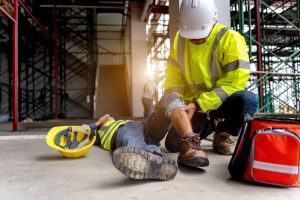The Danger of Falls in Construction Work
 Construction sites are a constant hub of activity. Workers must navigate complex scaffolding, ladders, and beams, often at significant heights. While the finished product may be a huge skyscraper or a sprawling bridge, the construction process itself is filled with danger. Falls are the leading cause of fatalities and serious injuries in the construction industry.
Construction sites are a constant hub of activity. Workers must navigate complex scaffolding, ladders, and beams, often at significant heights. While the finished product may be a huge skyscraper or a sprawling bridge, the construction process itself is filled with danger. Falls are the leading cause of fatalities and serious injuries in the construction industry.
The Bureau of Labor Statistics reports, “In 2021, nearly 1 in 5 workplace deaths occurred in the construction industry. Just over one-third of construction deaths were due to falls, slips, and trips. Of these, almost all were from falls to a lower level. The construction industry accounted for 46.2 percent of all fatal falls, slips, and trips in 2021.”
Occupational Safety and Health Administration (OSHA) reports that in 2020, falls were the number one leading cause of death on construction sites, and the majority of these falls are preventable.
These statistics highlight the prevalence and severity of falls in construction. Understanding the reasons behind these accidents is important, as it is for construction sites to implement effective preventative measures.
What are the common causes of falls on construction sites?
Construction site falls happen for a variety of reasons, including:
- Unguarded edges and openings: Missing guardrails, unprotected floor holes, and open pits are significant fall hazards. Workers may not be aware of these dangers or could lose their balance while working near them.
- Improper scaffolding: Inadequately constructed or poorly maintained scaffolding can collapse, give way, or become unstable, leading to falls. Additionally, workers may not be properly trained on safe scaffolding procedures.
- Unsafe ladder use: Using the wrong type of ladder for the job, exceeding the weight capacity, or failing to secure the ladder properly can all result in falls.
- Slips, trips, and falls on the same level: Uneven surfaces, debris on the ground, and poor cleanup can cause workers to slip, trip, and fall from a lower level.
- Falling objects: Tools, materials, or debris falling from above can strike workers below, causing them to lose balance and fall.
- Unguarded rebar: Protruding rebar can cause serious injuries, like impalement. OSHA states, “When employees are working at any height above exposed rebar, fall protection/prevention is the first line of defense against impalement.”
- Weather conditions: Rain, snow, and ice can create slippery surfaces and reduce visibility, increasing the risk of falls.
There are also different types of falls:
- Falls from heights: These are the most severe falls and can occur from scaffolding, roofs, ladders, or elevated platforms. The potential for serious injury or death increases with the height of the fall.
- Falls from the same level: Slips and trips on uneven surfaces or debris can cause workers to fall from their own height, still resulting in serious injuries like broken bones, sprains, and head trauma.
- Falls through openings: Uncovered floor holes, skylights, or wall openings can lead to workers falling through to lower levels.
What are the consequences of construction falls?
Falls in construction can have life-altering consequences. The severity of injuries depends on the height of the fall and the landing surface. Here’s a look at some potential outcomes of a construction site fall:
- Fatalities: Falls from heights are the leading cause of death in construction. Even falls from a seemingly low distance can be fatal if the head or neck is involved.
- Spinal cord injuries: Falls can damage the spinal cord, resulting in partial or complete paralysis.
- Traumatic brain injuries (TBIs): Head injuries sustained in falls can lead to cognitive impairments, memory loss, and personality changes.
- Broken bones: Fractures can occur anywhere in the body, often requiring surgery and extensive rehabilitation.
- Psychological trauma: The experience of a fall, especially a severe one, can lead to post-traumatic stress disorder (PTSD) and anxiety.
The financial repercussions of falls in construction are also substantial. Medical bills, lost wages, and long-term care costs associated with serious injuries can be devastating for workers and their families.
How can construction companies prevent falls?
Fortunately, most falls in construction are preventable. Following are some key strategies for mitigating these hazards. Employers should be responsible for:
- Developing and implementing a fall protection plan: This plan should outline specific safeguards for different types of work at height, including the use of guardrails, safety nets, and personal fall arrest systems.
- Providing proper training: Workers need comprehensive training on fall prevention techniques, safe use of ladders and scaffolding, and hazard recognition.
- Maintaining a safe work environment: Regular inspections of scaffolding, ladders, and other equipment are crucial. Additionally, employers should ensure a clean and debris-free workspace to minimize slips and trips.
- Enforcing safe work practices: Employers must have clear safety rules in place and enforce them consistently. This includes prohibiting workers from taking unnecessary risks or working in unsafe conditions.
- Providing personal fall arrest systems (PFAS): Workers should be equipped with appropriate PFAS for tasks requiring fall protection. Training on the proper selection, inspection, and use of PFAS is essential.
Workers can do their part, too:
- Follow safety rules and procedures: Workers have a responsibility to follow established safety protocols, wear required personal protective equipment (PPE), and report any unsafe work conditions.
- Inspect equipment before use: This includes ladders, scaffolding, and PFAS to ensure they are in good working order and free from defects.
- Maintain situational awareness: Workers should be alert to their surroundings and avoid distractions that could lead to slips or trips.
- Communicate concerns: If you observe an unsafe condition or feel pressured to work in a risky situation, you should speak up and report it to your supervisor.
On a related note, the National Safety Stand-Down To Prevent Falls in Construction Week takes place from May 6 through 10, 2024. Per OSHA, “A Safety Stand-Down is a voluntary event for employers to talk directly to employees about safety. Any workplace can hold a stand-down by taking a break to focus on Fall Hazards and reinforcing the importance of Fall Prevention.”
If you’ve been injured in a workplace accident, understand that you have legal rights and options available to you. At Larson Law, our Fargo worksite injury attorneys will stand by your side and work to ensure that those responsible for your injuries are held accountable. Don’t let insurance companies or employers downplay the severity of your injuries or deny you the compensation you deserve. With our experience handling worksite injury cases, we will fight tirelessly to protect your rights and pursue the full and fair compensation you are entitled to under the law. To schedule a free consultation with an experienced lawyer, call our offices or fill out our contact form. We handle accident cases on a contingency fee basis – meaning we don’t get paid until you get paid. We also maintain additional offices in Bismarck and Minot.

Mark Larson is a Certified Civil Trial Specialist and Certified Civil Pre-Trial Specialist focusing on personal injury, car accidents, wrongful death, and oil field claims. Since 1979, Larson Law has served the injured throughout North Dakota. Read more about Mark V. Larson.
